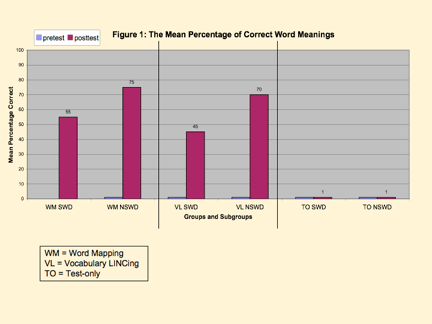Additional information
| AllAuthors | Edwin S. Ellis |
|---|---|
| Publisher | Edge Enterprises, Inc. |
| Requirements | |
| Year Printed | 2013 |
| Other Materials Needed | Vocabulary LINCing Routine |
| Includes | CD-ROM |
| FirstAuthor | Edwin S. Ellis |
Learning—and remembering—the meaning of new vocabulary words is not always easy! Students often have to take weekly tests covering the meaning of 20 or more vocabulary words. This is a daunting task for many students! All is not lost; they can use the LINCS Vocabulary Strategy to remember a vocabulary word and its meaning—now and in the future. The creation of rhyming words, simple stories, and pictures comprise this memory-enhancing strategy that enables students to expand their vocabulary and have fun in the process.
The Interactive LINCS flash drive can be used during instruction in the LINCS Vocabulary Strategy and in conjunction with the LINCing Routine. It contains digital LINCS Tables in color and blackline versions that can be filled in by teachers or students using their keyboards. The tables can be projected on a screen for demonstrations and class participation. Completed tables can be saved or emailed. Using this flash drive is a great way to get a whole class involved in vocabulary learning.
| AllAuthors | Edwin S. Ellis |
|---|---|
| Publisher | Edge Enterprises, Inc. |
| Requirements | |
| Year Printed | 2013 |
| Other Materials Needed | Vocabulary LINCing Routine |
| Includes | CD-ROM |
| FirstAuthor | Edwin S. Ellis |
Overview
The LINCing Routine is a set of procedures teachers use to teach students the LINCS Vocabulary Strategy. Students use the strategy to learn the meaning of a new word. The effects of teaching the LINCS Vocabulary Strategy were compared to the effects of teaching the Word Mapping Strategy in this study. The Word Mapping Strategy is a strategy students use to predict the meaning of new words. The study included a total of 230 ninth graders in nine intact general education English classes. Students with disabilities (SWDs) and without disabilities (NSWDs) were enrolled in each of the classes. Three classes participated in each of three groups: the group receiving instruction in the LINCS Vocabulary (VL) Strategy (n = 6 SWDs, 73 NSWDs), the group receiving instruction in the Word Mapping (WM) Strategy (n= 10 SWDs, 69 NSWDs) , and a comparison test-only [TO]) group (n = 8 SWDS, 64 NSWDs). Classes were randomly selected into the two experimental groups. The third group of classes served as a normative comparison. A pretest-posttest control-group design was combined with a pretest-posttest comparison-group design.
Results
Figure 1 displays the mean percentage of 20 words that students in both experimental groups (i.e., the VL an/ WM groups) learned during the strategy instruction as determined by a written test that required students to write the meaning of the words. The mean scores of VL students are depicted with the bars in the center of the figure. With regard to changes from pretest to posttest for the VL group, the three-way interaction of time x subgroup x group was found to be significant, Wilks’ Λ = .964, F(2,224) = 4.138, p = .017, partial η2 = .036 (a small effect size). When the file was split on subgroup, the time x group interaction was significant for the SWDs, F(2,21) = 12.90, p < .001, partial η2 = .563 (a large effect size), and for the NSWDs, F(2,203) = 367.388, p < .001, partial η2 = .780 (also a large effect size). The paired-sample t-tests revealed that significant differences were found between the pretest and posttest scores for the SWDs in the VL group, t(5) = -5.391, p = .003, d = 1.074 (a large effect size), and for the NSWDs in the VL group, t(72) = -26.879, p< .001, d = .089 (a medium effect size). No differences were found for the TO subgroups.

No differences were found between the posttest scores of the VL and WM groups on this measure. However, large significant differences were found between the posttest scores of the VL subgroups and the TO subgroups [SWDs: F(1,20) = 12.589, p <.01, partial η2 = .386 (a moderate effect size); NSWDs: F(1,202) = 543.479, p <.001, partial η2 = .730 (a large effect size).
Figure 2 displays the mean percentage of points students earned on a test of strategy use, with the mean scores for VL students on the right side of the figure. Students in the VL group took a test requiring use of the LINCS Vocabulary Strategy; students in the WM group took a test requiring use of the Word Mapping Strategy. With regard to the VL group, a significant difference was found between the pretest and posttest scores, Wilks’ Λ = .262, F(1,77) = 217.184, p < .001, partial η2= .738 (a large effect size). There were no differences between the SWDs and the NSWDs in learning the LINCS Vocabulary Strategy.

Conclusions
Students in ninth-grade general education classes were able to learn the LINCS Vocabulary Strategy and the meaning of words taught during strategy instruction. The effect sizes in each case were large. There were no differences in performance between the students with and without disabilities.
Reference for this study*
Harris, M. L., Schumaker, J. B., & Deshler, D. D. (in preparation). The effects of strategic morphological analysis instruction on the vocabulary performance of secondary students with and without disabilities. Available through Edge Enterprises, Inc. or call Edge for updated publication information.
*This research study won the Researcher of the Year Award from the Council for Learning Disabilities in 2008.

 Differentiated Visual Tools: Grades K-3 Reading and Writing Flash Drive
Differentiated Visual Tools: Grades K-3 Reading and Writing Flash Drive